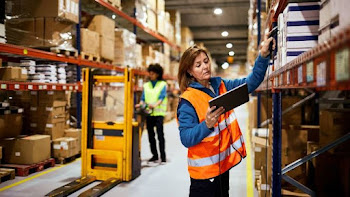RFID Definition 2025: How It Works & Why It Matters
1. What Is RFID? The Updated RFID Definition for 2025
The RFID Definition in 2025 refers to Radio Frequency Identification, a wireless system used to identify and track objects using radio waves. RFID uses a tag and a reader. The tag is attached to an item, and the reader picks up its signal to get information like identity, location, or status. This technology has improved significantly in recent years and is now faster, smarter, and more widely used across industries.
2. How RFID Works: Key Components and Process Explained
To understand the RFID Definition, it’s important to know how the system works. There are three main parts:
-
RFID Tags: These are small devices with a chip and antenna that store data.
-
RFID Reader: This device sends out radio signals and receives information from tags.
-
Backend System: This software processes and stores the data from tags for reporting and control.
The RFID reader sends a signal to the tag, which responds with stored data. This process is quick and doesn’t need a line of sight, unlike barcodes.
3. Types of RFID Systems Used in 2025
The RFID Definition includes several types of RFID systems. In 2025, the most common are:
-
Passive RFID: Tags don’t have batteries and are powered by the reader. Used for short-range tracking like inventory.
-
Active RFID: Tags have built-in batteries and send signals over long distances. Used in logistics and vehicle tracking.
-
Semi-passive RFID: Tags have batteries but only activate when prompted by a reader.
Each system has its own benefits, and businesses choose based on their tracking needs.
4. Top Applications of RFID Across Industries
The RFID Definition extends across multiple industries in 2025. Some key applications include:
-
Retail: Track clothing, electronics, and inventory levels in real time.
-
Healthcare: Monitor patients, medical equipment, and medication storage.
-
Logistics: Manage goods in warehouses, monitor shipments, and track fleet movement.
-
Catering Services: Companies like Jaffer Bhai’s use RFID to monitor food trays, kitchen tools, and delivery containers.
This versatility makes RFID one of the most useful technologies today.
5. Why RFID Matters in 2025: Key Benefits for Modern Businesses
The RFID Definition matters because of the many benefits it offers. These include:
-
Improved Accuracy: Reduce human error with automated tracking.
-
Real-Time Monitoring: Know the exact location of items instantly.
-
Faster Operations: Scan hundreds of items in seconds.
-
Cost Savings: Lower losses due to theft or misplacement.
Businesses now see RFID as a must-have tool for operational success.
6. RFID vs Barcode: What’s the Difference in 2025?
When comparing the RFID Definition to barcodes, several differences stand out:
-
RFID does not require direct line of sight, while barcodes do.
-
RFID can read multiple tags at once; barcodes require individual scanning.
-
RFID tags store more data and are more durable.
This makes RFID the better choice for businesses that need speed, accuracy, and automation.
7. How RFID Is Powering Smart Inventory Management
Inventory management is a key area where the RFID Definition has brought massive change. Retailers, warehouses, and catering services now rely on RFID to monitor stock levels. It automatically updates the system when items enter or leave a location. This helps prevent overstocking, understocking, and theft. In catering, RFID can track food items, kitchen equipment, and event supplies without manual checks.
8. RFID in Supply Chain and Logistics: Better Tracking in 2025
In logistics, the RFID Definition includes its use in tracking shipments from origin to destination. RFID tags attached to pallets, boxes, or containers provide real-time updates. Logistics managers can check where goods are, how long they’ve been in transit, and if anything is missing. This makes the entire supply chain more transparent and reliable.
9. The Role of RFID in Business Security and Access Control
The RFID Definition is not limited to object tracking. Many companies use RFID for access control. Staff carry RFID-enabled cards or badges to enter restricted areas. This is common in office buildings, hospitals, and event venues. The system logs entry and exit times, helping maintain security and accountability.
10. The Future of RFID Technology: What’s Ahead Beyond 2025
The future of the RFID Definition involves deeper integration with artificial intelligence and the Internet of Things (IoT). Soon, RFID systems will do more than track—they’ll predict when supplies are running low, alert managers to delays, and suggest restocking schedules. New innovations may include:
-
RFID + Sensors: Monitor temperature or humidity with RFID tags in food and medicine.
-
Blockchain + RFID: Create tamper-proof records of item movement.
-
Mobile RFID: Use smartphones as RFID readers for smaller businesses.
These developments will make RFID even more valuable in the years to come.
Meta Description (SEO Optimized):
Discover the RFID Definition in 2025, how it works, and why it’s crucial for modern industries. Learn about its applications, benefits, and future potential.
Call to Action:
Looking to upgrade your tracking systems? Contact AIDC Technologies India for customized RFID solutions that transform your operations using the latest technology.


Comments
Post a Comment